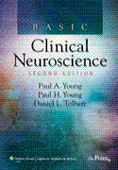Basic Clinical Neuroscience offers medical and other health
professions students a clinically oriented description of human
neuroanatomy and neurophysiology. This text provides the anatomic and
pathophysiologic basis for understanding neurologic abnormalities
through concise descriptions of functional systems with an emphasis
on medically important structures and clinically important pathways.
It emphasizes the localization of specific anatomic structures and
pathways with neurological deficits, using anatomy enhancing 3-D
illustrations.
Basic Clinical Neuroscience also includes boxed clinical information
throughout the text, a key term glossary section, and review
questions at the end of each chapter, making this book comprehensive
enough to be an excellent Board Exam preparation resource in addition
to a great professional training textbook.
The fully searchable text will be available online at thePoint.
----------------------------------------------------------------------
----------
목차
차 례
ORGANIZATION, CELLULAR COMPONENTS, AND TOPOGRAPHY OF THE CNS
Introduction to the Nervous System: Organization, Functional Units,
and Supporting Structures
Spinal Cord Topography and Functional Levels
Brainstem Topography and Functional Levels
Forebrain Topography and Functional Levels
MOTOR SYSTEMS
Lower Motor Neurons: Flaccid Paralysis
The Pyramidal System: Spastic Paralysis
Spinal Motor Organization and Brainstem Supraspinal Paths:
Postcapsular Lesion Recovery and Decerebrate Posturing
The Basal Ganglia: Dyskinesia
The Cerebellum: Ataxia
The Ocular Motor System: Gaze Disorders
SENSORY SYSTEMS
The Somatosensory System: Anesthesia and Analgesia
The Auditory System: Deafness
The Vestibular System: Vertigo and Nystagmus
The Visual System: Anopsia
The Gustatory and Olfactory Systems: Ageusia and Anosmia
THE CEREBRAL CORTEX AND LIMBIC SYSTEM
The Cerebral Cortex: Aphasia, Agnosia, and Apraxia
The Limbic System: Anterograde Amnesia and Inappropriate Social
Behavior
THE AUTONOMIC SYSTEM
The Hypothalamus: Vegetative and Endocrine Imbalance
The Autonomic Nervous System: Visceral Abnormalities
THE BRAINSTEM AND CRANIAL NERVES
Reticular Formation: Modulation and Activation
The Cranial Nerves: Organization and Abnormalities
ACCESSORY COMPONENTS
The Circulation of the CNS: Stroke
The Cerebrospinal Fluid System: Hydrocephalus
DEVELOPMENT, AGING, AND PLASTICITY
Development of the Nervous System: Congenital Anomalies
Aging of the Nervous System: Dementia
Recovery of Function of the Nervous System: Plasticity and
Regeneration
WHERE IS THE LESION?
Clinical Illustrations and Principles for Locating Lesions
APPENDICES
Glossary
Suggested Readings
Atlas of Myelin Stained Sections
Answers to Chapter Questions


